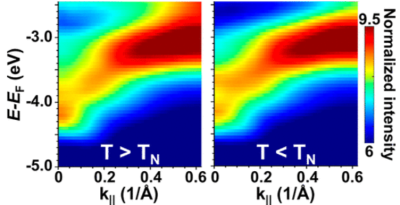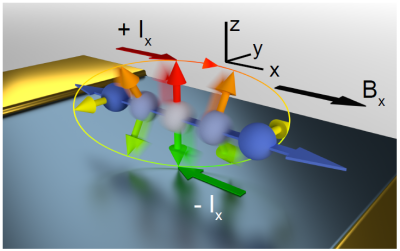Current events
Next talk tomorrow at 11:30 by Alexander Polkowski!
News 23.12.2025
Season's greetings from the 2D Materials and Quantum Devices Group!
Site Content:
23.12.2025
Season's greetings from the 2D Materials and Quantum Devices Group!
As the year comes to an end, we would like to extend our warmest wishes to you all. We are grateful for the commitment, curiosity and collaborative spirit that have shaped our work over the past year.
We would like to thank all our colleagues, collaborators and students for the stimulating exchanges and shared progress, and we look forward to continuing these efforts in the coming year.
We wish you a peaceful holiday season and a successful and inspiring New Year 2026!


18.12.2025
New publication: Radio-Frequency Charge Detection on Graphene Electron–Hole Double Quantum Dots

Nano Letters 25, 17685 (2025) High-fidelity detection of charge transitions in quantum dots (QDs) is a key ingredient in solid-state quantum computation. We demonstrate high-bandwidth radio-frequency charge detection in bilayer graphene quantum dots (QDs) using a capacitively coupled quantum point contact (QPC). The device design suppresses screening effects and enables a sensitive QPC-based charge readout. The QPC is arranged to maximize the readout contrast between two neighboring coupled electron and hole QDs. We apply the readout scheme to a single-particle electron–hole double QD and demonstrate time-resolved detection of charge states as well as magnetic field dependent tunneling rates. This promises a high-fidelity readout scheme for individual spin and valley states, which is important for the operation of spin, valley, or spin-valley qubits in bilayer graphene.

17.12.2025
New publication: Probing the Band Structure of the Strongly Correlated Antiferromagnet NiPS3 across Its Phase Transition

ACS Nano 19, 42737 (2025)
NiPS3 is an exfoliable van der Waals intralayer antiferromagnet with a zigzag-type spin arrangement. It is distinct from other TMPS3 (TM: transition metal) materials by optical excitations into a strongly correlated state that is tied to the magnetic properties. However, the related fundamental band structure across the antiferromagnetic phase transition has not been probed yet. Here, we use angular-resolved photoelectron spectroscopy with μm resolution in combination with DFT + U calculations for that purpose. We identify a characteristic band shift across the TN. It is attributed to bands of mixed Ni and S character related to the superexchange interaction of the Ni 3t

16.12.2025
New publication: Trembling motion of electrons driven by Larmor spin precession

npj Spintronics 3, 52 (2025) We show that the initialization of an ensemble of electrons in the same spin state in strained n-InGaAs subject to a perpendicular magnetic field triggers an AC electric current at GHz frequencies. The AC current emerges in the absence of any electric driving force and survives until the coherent precession of the electron spins is lost. The current amplitude increases linearly with both the spin-orbit coupling strength and the external magnetic field. The generation mechanism of the observed oscillatory charge motion can be fruitfully described in terms of the periodic trembling motion of spin-polarized electrons, which is a solid-state analog to the Zitterbewegung of free Dirac electrons. Our results demonstrate that the hidden consequence of relativistic quantum mechanics is realized and can be studied in a rather simple solid-state system at moderate temperatures. Furthermore, the large amplitude of the AC current at high magnetic fields enables ultra-fast spin sensitive electric read-out in solids.

10.12.2025
Taoufiq Ouaj successfully defended his PhD thesis
On Wednesday, 10 December 2025, Taoufiq Ouaj successfully defended his PhD thesis. We warmly congratulate Dr. Taoufiq Ouaj on this great achievement! A big thank-you and congratulations also go to the entire team for the fantastic "Doktorhut".


08.12.2025
New publication: MaskTerial: a foundation model for automated 2D material flake detection

Digital Discovery 4, 3744(2025) The detection and classification of exfoliated two-dimensional (2D) material flakes from optical microscope images can be automated using computer vision algorithms. This has the potential to increase the accuracy and objectivity of classification and the efficiency of sample fabrication, and it allows for large-scale data collection. Existing algorithms often exhibit challenges in identifying low-contrast materials and typically require large amounts of training data. Here, we present a deep learning model, called MaskTerial, that uses an instance segmentation network to reliably identify 2D material flakes. The model is extensively pre-trained using a synthetic data generator that generates realistic microscopy images from unlabeled data. This results in a model that can quickly adapt to new materials with as little as 5 to 10 images. Furthermore, an uncertainty estimation model is used to finally classify the predictions based on optical contrast. We evaluate our method on eight different datasets comprising five different 2D materials and demonstrate significant improvements over existing techniques in the detection of low-contrast materials such as hexagonal boron nitride.

14.11.2025
RWTH’s “5 to 12” Science Night
Once again, the Wissenschaftsnacht at RWTH Aachen proved to be a resounding success! This year, as in previous years, many members of our group contributed their time and expertise to make the evening a memorable experience for visitors.
Please find here a link to a youtube-video about it: "5 vor 12" - Die RWTH-Wissenschaftsnacht 2025


11.11.2025
New publication: Tailoring Phonon Polaritons in hBN with the Plasmonic Phase-Change Material In3SbTe2

Nano Letters 25, 15809 (2025) Polaritons in van-der-Waals materials (vdWMs) promise high confinement and multiple tailoring options by resonators and launching structures which conventionally require cumbersome lithography techniques. Optical programming of phase-change materials (PCMs) offers fast and reconfigurable fabrication of these structures. As the plasmonic PCM In3SbTe2 can be switched between a dielectric and metallic phase, In3SbTe2 is promising for optical programming of metallic launching structures to tailor and confine polaritons in vdWMs. Here, we combine the vdWM hexagonal boron nitride (hBN) with In3SbTe2 and optically program circular resonators for hBN’s phonon polaritons into In3SbTe2. We investigate the polariton resonators with near-field optical microscopy. Demonstrating the reconfigurability, we decrease the resonator diameter to increase the confinement up to λ/39 and achieve a quality factor of 72. Finally, we fabricate a focusing structure for hBN’s polaritons whose focal point we reconfigure. We promote In3SbTe2 as a versatile platform for rapid prototyping of polariton optics in vdWMs.

Showing 1 - 8 (283 total) - Next
